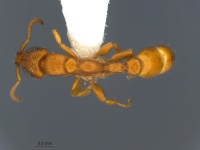Tetraponera ambigua
| Tetraponera ambigua | |
|---|---|
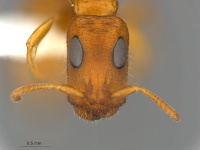
| |
| Scientific classification | |
| Kingdom: | Animalia |
| Phylum: | Arthropoda |
| Class: | Insecta |
| Order: | Hymenoptera |
| Family: | Formicidae |
| Subfamily: | Pseudomyrmecinae |
| Genus: | Tetraponera |
| Species group: | ambigua |
| Species: | T. ambigua |
| Binomial name | |
| Tetraponera ambigua (Emery, 1895) | |
| Synonyms | |
| |
This species is a generalist inhabitant of dead twigs, and appears to be more common in semi-arid environments than in rainforest.
Identification
A member of the Tetraponera ambigua-group.
Ward (2006) - Within the T. ambigua-group the worker of this species is characterized by its intermediate size, relatively small eyes (REL2 0.54 - 0.60), relatively flat profile of the mesosoma dorsum, and abundant standing pilosity. There is some variability in the configuration of the median clypeal lobe, shape of the petiole and details of sculpture – as might be expected in a widespread species – but the variation appears to be continuous and is consistent with the hypothesis of a single polytypic species. Of course, a more detailed genetic and phenotypic analysis might reverse this judgment.
Keys including this Species
- Key to Afrotropical Tetraponera species-groups
- Key to Tetraponera ambigua group species
- Key to Afrotropical Tetraponera
- Key to Afrotropical Tetraponera species
Distribution
This widespread species is found from the Arabian Peninsula and the Sahara south to South Africa.
Latitudinal Distribution Pattern
Latitudinal Range: 31.966667° to -33.46667°.
| North Temperate |
North Subtropical |
Tropical | South Subtropical |
South Temperate |
- Source: AntMaps
Distribution based on Regional Taxon Lists
Afrotropical Region: Angola, Botswana, Cameroun, Democratic Republic of Congo, Djibouti, Ethiopia, Gabon, Gambia, Kenya, Mozambique, Namibia, Saudi Arabia, Senegal, Somalia, South Africa (type locality), Sudan, United Arab Emirates, United Republic of Tanzania, Yemen, Zimbabwe.
Palaearctic Region: Algeria, Egypt, Israel, Libya.
Distribution based on AntMaps
Distribution based on AntWeb specimens
Check data from AntWeb
Countries Occupied
| Number of countries occupied by this species based on AntWiki Regional Taxon Lists. In general, fewer countries occupied indicates a narrower range, while more countries indicates a more widespread species. |

|
Estimated Abundance
| Relative abundance based on number of AntMaps records per species (this species within the purple bar). Fewer records (to the left) indicates a less abundant/encountered species while more records (to the right) indicates more abundant/encountered species. |

|
Biology
It is dimorphic with soldiers and workers. Found nesting in dead twigs in dry habitats.
Castes
Worker
 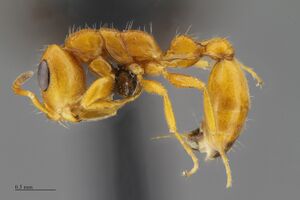  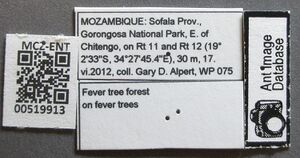 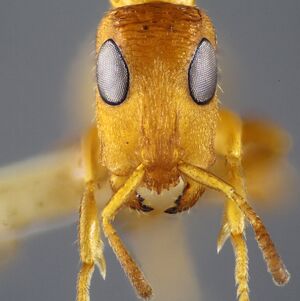 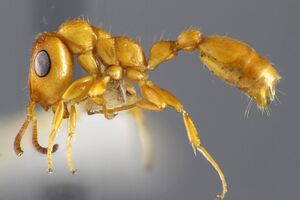  
| |
| . | |
Queen
  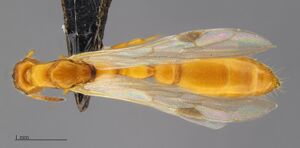 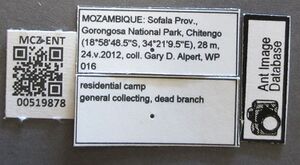
| |
| . | |
Male
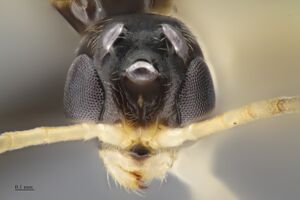   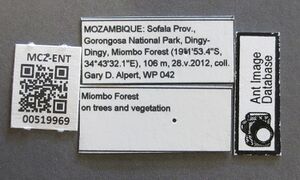
| |
| . | |
Nomenclature
The following information is derived from Barry Bolton's Online Catalogue of the Ants of the World.
- ambigua. Sima ambigua Emery, 1895h: 23 (w.q.) SOUTH AFRICA. Forel, 1910f: 5 (m.). Combination in S. (Tetraponera): Arnold, 1916: 185; in Tetraponera: Wheeler, W.M. 1922a: 796. [Sima ambigua Forel, 1894b: 89. Nomen nudum, attributed to Emery.] Senior synonym of angolensis, bifoveolata, encephala, erythraea, maculifrons, occidentalis, rhodesiana, syriaca: Ward, 2006: 123.
- bifoveolata. Sima bifoveolata Mayr, 1895: 146 (w.) MOZAMBIQUE, TANZANIA (Zanzibar I.).
- [Misspelled as foveolata by Santschi, 1912b: 162.]
- Menozzi, 1926a: 37 (q.).
- Combination in S. (Tetraponera): Arnold, 1916: 184; Emery, 1921f: 27;
- combination in Tetraponera: Wheeler, W.M. 1922a: 796.
- Status as species: Mayr, 1904b: 4; Arnold, 1916: 184; Emery, 1921f: 27; Wheeler, W.M. 1922a: 796; Menozzi, 1926a: 37; Menozzi, 1930b: 81; Santschi, 1935b: 266; Finzi, 1936: 157; Collingwood, 1985: 240; Kugler, J. 1988: 256; Bolton, 1995b: 417; Collingwood & Agosti, 1996: 312; Taylor & McGavin, 2020: 14.
- Junior synonym of ambigua: Ward, 2006: 123; Collingwood, et al. 2011: 421.
- erythraea. Sima ambigua subsp. erythraea Emery, 1895h: 23 (w.) YEMEN.
- [Sima ambigua susbp. erythraea Emery, 1893f: 256. Nomen nudum.]
- Combination in S. (Tetraponera): Emery, 1921f: 27;
- combination in Tetraponera: Wheeler, W.M. 1922a: 796.
- Subspecies of ambigua: Stitz, 1917: 335; Emery, 1921f: 27; Wheeler, W.M. 1922a: 796; Finzi, 1940: 156.
- Status as species: Collingwood, 1985: 242; Bolton, 1995b: 418; Collingwood & Agosti, 1996: 312 (in key); Taylor & McGavin, 2020: 15.
- Junior synonym of ambigua: Ward, 2006: 123.
- maculifrons. Sima bifoveolata st. maculifrons Santschi, 1912b: 162 (w.) SOMALIA. [Name misspelled as foveolata in original description.] Combination in Sima (Tetraponera): Emery, 1921f: 27; in Tetraponera: Wheeler, W.M. 1922a: 796. Junior synonym of ambigua: Ward, 2006: 123.
- rhodesiana. Sima ambigua r. rhodesiana Forel, 1913a: 112 (w.) ZIMBABWE. Arnold, 1914: 31 (s.w.); Arnold, 1916: 187 (q.). Combination in S. (Tetraponera): Arnold, 1916: 186; in Tetraponera: Wheeler, W.M. 1922a: 796. Junior synonym of ambigua: Ward, 2006: 123.
- syriaca. Sima bifoveolata var. syriaca Wheeler, W.M. & Mann, 1916: 167 (w.) SYRIA. Combination in S. (Tetraponera): Emery, 1921f: 27; in Tetraponera: Ward, 1990: 489. Junior synonym of ambigua: Ward, 2006: 123.
- encephala. Sima encephala Santschi, 1919h: 84 (q.) SENEGAL. Combination in Tetraponera: Wheeler, W.M. 1922a: 797. Junior synonym of ambigua: Ward, 2006: 123.
- angolensis. Tetraponera ophthalmica st. angolensis Santschi, 1930b: 61, fig. 1 (w.) ANGOLA. Junior synonym of ambigua: Ward, 2006: 123.
- occidentalis. Tetraponera ambigua var. occidentalis Menozzi, 1934: 154 (w.) ALGERIA. [First available use of Sima ambigua r. erythraea var. occidentalis Stitz, 1917: 336. Unavailable name (Ward, 1990: 489).] Junior synonym of ambigua: Ward, 2006: 123.
Taxonomic Notes
Sima bifoveolata
Taylor & McGavin (2020) treat the junior synonym Sima bifoveolata as a valid species. However, they provide no evidence to support this conclusion, stating that it is a "A fairly small ant, minor TL 3.8-4.2 mm, major TL 4.5-5.0 mm. The minor exactly matches the alitrunk and gaster of the type. This appears to be the first finding of a major worker and Ward gave no indication of a major for T. ambigua." This proposal is not followed here.
Tetraponera erythraea
Taylor & McGavin (2020) treat this taxon as a valid species. They found that "T. erythraea has the alitrunk profile in three shallow convexities, with quite abundant erect hairs, whereas the alitrunk on the T. ambigua type is near flat and there are few, very short, erect hairs [based on the type image on AntWeb.org at CASENT0904033]. The junior synonym of T. ambigua, rhodesiana is identical." They note that Ward (2006) states that T. ambigua has "abundant standing pilosity" and then note "that the types of T. ambigua and rhodesiana do not show abundant standing pilosity". The T. ambigua type specimen imaged by AntWeb (CASENT0904033) clearly shows several elongate hairs. As this is an older specimen it might be expected to have suffered damage since being collected and thus may not have a full complement of hairs. Relying on a single specimen (the type) to characterise an entire species may lead to incorrect conclusions as it is not possible to gauge variation within the species or detect damage to a single specimen. Until T. ambigua and all related forms can be reassessed, it seems prudent to retain T. erythraea as a junior synonym of T. ambigua.
Unless otherwise noted the text for the remainder of this section is reported from the publication that includes the original description.
Description
Worker
Ward (2006) - (n = 14). HW 0.61 - 0.71, HL 0.86 - 0.99, LHT 0.55 - 0.63, CI 0.69 - 0.79, FCI 0.19 - 0.25, REL 0.41 - 0.45, REL2 0.54 - 0.60, SI 0.52 - 0.60, SI3 0.89 - 1.07, FI 0.43 - 0.51, PLI 0.56 - 0.76, PWI 0.47 - 0.59, LHT / HW 0.84 - 0.94, CSC 18 - 40, MSC 12 - 44.
Masticatory margin of mandible with four teeth; anterior margin of median clypeal lobe varying from convex and crenulate to obtusely tridentate; median lobes of antennal sclerites expanded laterally and covering most of the antennal insertions; ocelli absent or represented by a pair of weak lateral ocelli; pronotum laterally submarginate; mesosoma dorsum more or less flat in profile, mesosonotum weakly convex and not separated from anterior margin of propodeum by prominently raised metanotal spiracles; dorsal face of propodeum subequal in length to declivitous face, the two surfaces better differentiated than in other T. ambigua-group species; petiole relatively robust, less than twice as long as high; metabasitarsal sulcus absent. Integument coriarious/puncticulate and sublucid; a pair of more coarsely sculptured patches of cuticle variably developed on posterolateral corners of head; side of propodeum with varying amounts of weak irregular longitudinal carinulae, extending onto adjacent mesopleuron. Standing pilosity common (see CSC and MSC values), present on mesonotum and propodeum; scattered appressed pubescence on most of body, moderately dense on abdominal tergite 4 (hairs separated by less than their lengths). Pale yellowish-orange to orange-brown.
Type Material
Ward (2006) - Syntypes, 1 worker, Hammans Kraal, South Africa (leg. Simon), 1 dealate queen, Makapan, South Africa (leg. Simon) (Museo Civico di Storia Naturale, Genoa) [examined].
References
- Arnold, G. 1916. A monograph of the Formicidae of South Africa. Part II. Ponerinae, Dorylinae. Ann. S. Afr. Mus. 14: 159-270 (page 185, Combination in S. (Tetraponera))
- Borowiec, L. 2014. Catalogue of ants of Europe, the Mediterranean Basin and adjacent regions (Hymenoptera: Formicidae). Genus (Wroclaw) 25(1-2): 1-340.
- Collingwood, C.A., Agosti, D., Sharaf, M.R., van Harten, A. 2011. Order Hymenoptera, family Formicidae. Arthropod fauna of the UAE 4: 405-474.
- Emery, C. 1895i. Voyage de M. E. Simon dans l'Afrique australe (janvier-avril 1893). 3e mémoire. Formicides. Ann. Soc. Entomol. Fr. 64: 15-56 (page 23, worker, queen described)
- Forel, A. 1894b. Abessinische und andere afrikanische Ameisen, gesammelt von Herrn Ingenieur Alfred Ilg, von Herrn Dr. Liengme, von Herrn Pfarrer Missionar P. Berthoud, Herrn Dr. Arth. Müller etc. Mitt. Schweiz. Entomol. Ges. 9: 64-100 (page 89, Sima ambigua; nomen nudum, attributed to Emery)
- Forel, A. 1910e. Zoologische und anthropologische Ergebnisse einer Forschungsreise im westlichen und zentralen Südafrika ausgeführt in den Jahren 1903-1905 von Dr. Leonhard Schultze. Vierter Band. Systematik und Tiergeographie. D) Formicidae. Denkschr. M (page 5, male described)
- Pekár, S., Haddad, C. 2011. Trophic strategy of ant-eating Mexcala elegans (Araneae: Salticidae): looking for evidence of evolution of prey-specialization. Journal of Arachnology 39, 133–138 (doi:10.1636/hi10-56.1).
- Taylor, B., McGavin, G. 2020. Ants found on acacia of the genus Vachellia. Belgian Journal of Entomology 99: 1-47.
- Ward, P. S. 2022. The ant genus Tetraponera (Hymenoptera: Formicidae) in the Afrotropical region: taxonomic review and key to species. Zootaxa 5102 (1):1-70 (doi:10.11646/zootaxa.5102.1.1).
- Ward, P.S. 2006. The ant genus Tetraponera in the Afrotropical region: synopsis of species groups and revision of the T. ambigua-group. Myrmecologische Nachrichten 8: 119-130.
- Wheeler, W. M. 1922j. Ants of the American Museum Congo expedition. A contribution to the myrmecology of Africa. VIII. A synonymic list of the ants of the Ethiopian region. Bull. Am. Mus. Nat. Hist. 45: 711-1004 (page 796, Combination in Tetraponera)
References based on Global Ant Biodiversity Informatics
- Arnold G. 1916. A monograph of the Formicidae of South Africa. Part II. Ponerinae, Dorylinae. Annals of the South African Museum. 14: 159-270.
- Baroni Urbani C. 1977. Katalog der Typen von Formicidae (Hymenoptera) der Sammlung des Naturhistorischen Museums Basel (2. Teil). Mitt. Entomol. Ges. Basel (n.s.) 27: 61-102.
- Bernard F. 1950. Contribution à l'étude de l'Aïr. Hyménoptères Formicidae. Mém. Inst. Fr. Afr. Noire 10: 284-294.
- Bernard F. 1953. Les fourmis du Tassili des Ajjer. Pp. 121-250 in: Bernard, F. (ed.) 1953. Mission scientifique au Tassili des Ajjer (1949). Volume I. Recherches zoologiques et médicales. Paris: P. Lechevalier, 302 pp.
- Borowiec L. 2014. Catalogue of ants of Europe, the Mediterranean Basin and adjacent regions (Hymenoptera: Formicidae). Genus (Wroclaw) 25(1-2): 1-340.
- Borowiec L., and S. Salata. 2018. Notes on ants (Hymenoptera: Formicidae) from Gambia (Western Africa). Annals of the Upper Silesian Museum in Bytom Entomology 26: 1-13.
- Braet Y., and B. Taylor. 2008. Mission entomologique au Parc National de Pongara (Gabon). Bilan des Formicidae (Hymenoptera) recoltes. Bulletin S. R. B. E./K.B.V.E. 144: 157-169.
- Cagniant, H. "Étude de quelques fourmis marocaines. Statistique provisoire des Formicidae du Maroc." Bulletin de la Société d' Histoire naturelle de l' Afrique du Nord 53 (1964): 83-118.
- Collingwood, C. A., and Donat Agosti. "Formicidae (Insecta: Hymenoptera) of Saudi Arabia (Part 2)." Fauna of Saudi Arabia 15 (1996): 300-385.
- El-Hawagry M. S., M. W. Khalil, M. R. Sharaf, H. H. Fadl, and A. S. Aldawood. 2013. A preliminary study on the insect fauna of Al-Baha Province, Saudi Arabia, with descriptions of two new species. ZooKeys 274: 188. doi:10.3897/zookeys.274.4529
- Emery C. 1895. Voyage de M. E. Simon dans l'Afrique australe (janvier-avril 1893). 3e mémoire. Formicides. Annales de la Société Entomologique de France 64: 15-56.
- Finzi B. 1940. Formiche della Libia. Memorie della Societa Entomologica Italiana 18: 155-166.
- Forel A. 1901. Einige neue Ameisen aus Südbrasilien, Java, Natal und Mossamedes. Mitteilungen der Schweizerischen Entomologischen Gesellschaft. 10: 297-311.
- Forel A. 1903. Einige neue Ameisen aus Sud-Angola. Pp 559-564, in: Baum, H. Kunene-Sambesi-Expedition, 1903. Berlin: Verlag des Kolonial-Wirtschaftlichen Komitees, 593pp.
- Forel A. 1910. Zoologische und anthropologische Ergebnisse einer Forschungsreise im westlichen und zentralen Südafrika ausgeführt in den Jahren 1903-1905 von Dr. Leonhard Schultze. Vierter Band. Systematik und Tiergeographie. D) Formicidae. Denkschriften der Medizinisch-Naturwissenschaftlichen Gesellschaft zu Jena 16: 1-30.
- Garcia F.H., Wiesel E. and Fischer G. 2013.The Ants of Kenya (Hymenoptera: Formicidae)Faunal Overview, First Species Checklist, Bibliography, Accounts for All Genera, and Discussion on Taxonomy and Zoogeography. Journal of East African Natural History, 101(2): 127-222
- IZIKO South Africa Museum Collection
- Kugler J. 1988. The zoogeography of Israel. 9. The zoogeography of social insects of Israel and Sinai. Monographiae biologicae 62: 251-275.
- Marsh A. C. 1986. Checklist, biological notes and distribution of ants in the central Namib Desert. Madoqua 14: 333-344.
- Menozzi C. 1930. Formiche della Somalia italiana meridionale. Memorie della Società Entomologica Italiana. 9: 76-130.
- Menozzi C. 1934. Reperti mirmecofaunistici raccolti dal Prof. L di Caporiacco nelle oasi di Cufra e in altre localita del deserto Libico. Atti della Societa dei Naturalisti e Matematici di Modena (6)13(65): 153-166
- Prins A. J. 1964. Revised list of the ants collected in the Kruger National Park. Koedoe 7: 77-93.
- Santschi F. 1935. Hymenoptera. I. Formicidae. Mission Scientifique de l'Omo 2: 255-277.
- Santschi, F. 1934. Fourmis du Sahara central. Memoires de la Société d'Histoire Naturelle d'Afrique du Nord 4: 165-177.
- Santschi, F. "Résultats de la Mission scientifique suisse en Angola, 1928-1929. Formicides de l'Angola." Revue Suisse de Zoologie 37 (1930): 53-81.
- Stitz, H. "Ameisen aus dem westlichen Mittelmeergebiet und von den Kanarischen Inseln." Mitteilungen aus den Zoologischen Museum in Berlin 8 (1917): 333-353.
- Vonshak M., and A. Ionescu-Hirsch. 2009. A checklist of the ants of Israel (Hymenoptera: Formicidae). Israel Journal of Entomology 39: 33-55.
- Ward. P. S. 2006. The ant genus Tetraponera in the Afrotropical region: synopsis of species groups and revision of the T. ambigua-gropu (Hymenoptera: Formicidae). Mymecologische Nachrichten 8: 119-130.
- Wheeler W. M. 1922. Ants of the American Museum Congo expedition. A contribution to the myrmecology of Africa. VIII. A synonymic list of the ants of the Ethiopian region. Bulletin of the American Museum of Natural History 45: 711-1004
- Wheeler W. M. and W. M. Mann. 1916. The ants of the Phillips Expedition to Palestine during 1914. Bulletin of the Museum of Comparative Zoology 60: 167-174.
- Wheeler W. M., and W. M. Mann. 1916. The ants of the Phillips Expedition to Palestine during 1914. Bulletin of the Museum of Comparative Zoology 60: 167-174.

